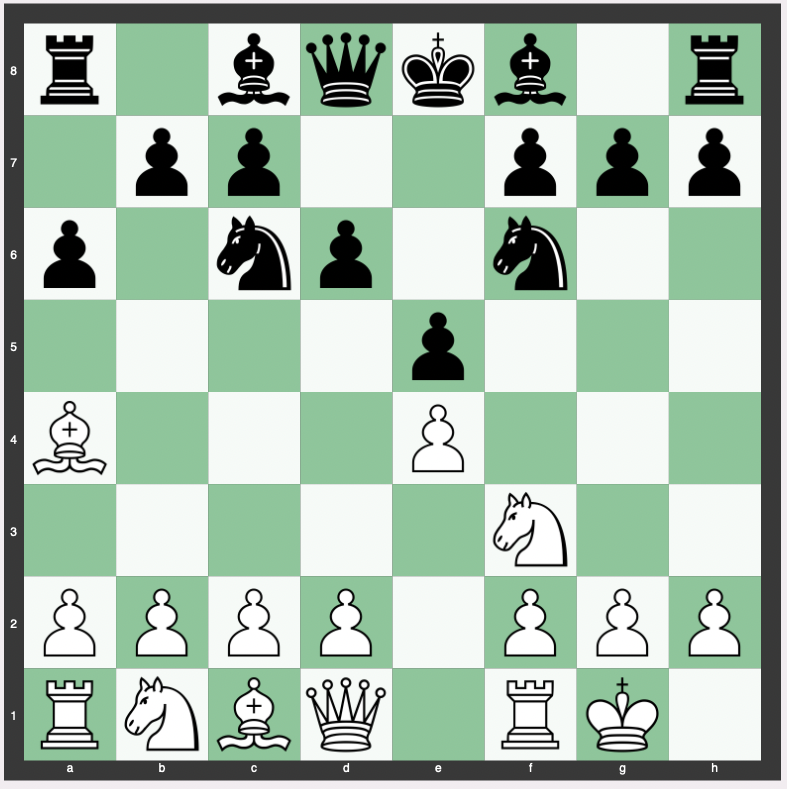The Steinitz Defense Deferred – also known as the Russian Defense – is a response to the Ruy Lopez, a classic and widely popular opening in the game of chess.
The Ruy Lopez, initiated by 1. e4 e5 2. Nf3 Nc6 3. Bb5, is named after the Spanish bishop who first documented it in the 16th century.
In response, the Russian Defense (similar to the Modern Steinitz Defense and known as the Steinitz Defense Deferred) commences with the moves 3…a6 4. Ba4 Nf6 5. O-O d6.
Move Order of the Steinitz Defense Deferred
In the Steinitz Defense Deferred, the move order is crucial to accurately establish the opening.
After white’s first three moves (1. e4 e5 2. Nf3 Nc6 3. Bb5), black responds with a6.
This move prompts white’s bishop to retreat to a4.
Then black continues with Nf6, attacking white’s central pawn on e4.
This move order concludes with white castling (O-O), followed by black’s move d6, bolstering the central pawn structure.
Theory, Strategy, and Purpose of the Steinitz Defense Deferred
The main purpose of the Steinitz Defense Deferred is to create a solid, compact structure that can withstand white’s opening onslaught.
Black’s move 5…d6 is pivotal, reinforcing the e5 pawn and preparing for a potential Bishop deployment to e7.
Black’s strategy is often to counter-attack in the center once the defensive setup is complete, targeting white’s potentially overextended pawns.
The Russian Defense’s theory prioritizes positional play and strategic planning over rapid tactical skirmishes.
Variations of the Steinitz Defense Deferred
The Steinitz Defense Deferred includes several variations, each with its unique characteristics.
One key variation arises after white’s 6. d4, to which black can respond with 6…b5, kicking the bishop further back and securing more space on the queen’s side.
Another variant could be 6…exd4, aiming for an open game with equal control over the center.
The chosen variation typically reflects the player’s style and strategic preferences.
History of the Steinitz Defense Deferred
The Russian Defense, despite its name, was actually popularized by the German chess player Wilhelm Steinitz, who was the first official World Chess Champion.
Steinitz used this defense with great success during the late 19th century, and it became part of his modern approach to the game, focusing on structure and slow accumulation of advantages.
Its name, the Russian Defense, likely comes from its frequent use by Russian masters in the 20th century.
Is the Steinitz Defense Deferred Good for Beginners or Intermediates?
The Steinitz Defense Deferred is suitable for both beginners and intermediate players, due to its emphasis on solid pawn structure and strategic play rather than complicated tactical exchanges.
For beginners, it provides an opportunity to learn about the principles of pawn structure and development, while for intermediate players, it offers a platform to explore deeper positional strategies and nuanced endgame plans.
How Often Is the Steinitz Defense Deferred Played at the Grandmaster Level?
The Steinitz Defense Deferred is not as frequently seen at the highest levels of play as other lines in the Ruy Lopez, such as the most common Closed Ruy Lopez or the Open Ruy Lopez lines.
However, it is far from obsolete and is occasionally employed as a surprise weapon or in situations where a solid, drawish approach is required.
Renowned players like former World Champion Anatoly Karpov and Grandmaster Sergey Tiviakov have utilized it in their repertoire, proving its viability at the grandmaster level.
It is part of the ECO C79 family.
ECO C79 Ruy Lopez, Steinitz defense deferred (Russian defense) (White perspective)
Conclusion
The Steinitz Defense Deferred is a unique response to the Ruy Lopez that emphasizes a robust and compact pawn structure.
This approach, requiring less tactical sharpness and more strategic thinking, makes it a suitable choice for both beginners and intermediate players.
While it may not be the most frequent choice at the grandmaster level, its historical use and ongoing application demonstrate its enduring value in the diverse universe of chess openings.
The Russian Defense, like the game of chess itself, is a testament to the rich strategic depth and variety the game has to offer.


